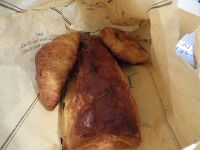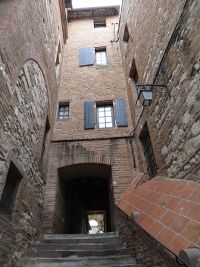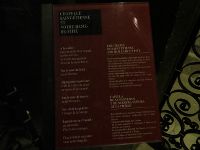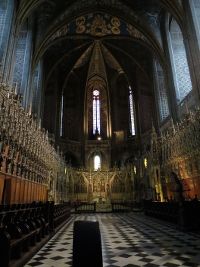Day 14 - 26th October - Albi: Cathedral (Part 1)

Toulouse SNCF Station
While waiting for my train I had a look at the Canal du Midi near the train station:

Canal du Midi

Directly opposite the station - between Médecins du Monde and a 3 Star Hotel, was a strip club

Yassa: the first African restaurant I'd ever seen (I think - occasionally I'd seen them on foursquare [possibly mistagged] but never bumped into a real one). Definitely the first I'd seen in this trip. The door has a map of Africa made mostly up of country names. Somehow they ran out of country names but South Africa is not there.

Locks

Station with space dedicated to WWII hero
I didn't know there was fighting this far south


Mmm


Cannelé, Gourmandise, Mini Escargot aux Raisins, Mini Croissant
This Paul was cheaper than I recalled. Maybe because it was not in Paris.
The cannelé was spongy and spiced inside, and crispy outside.
The Gourmandise was super flaky with chocolate inside. This Paul was better than I remembered - again, maybe because it was not in Paris. Hurrah for les provinces !
I then arrived in Albi.

Public baths
I was surprised by this and asked the lady about it. She said not everyone had a shower at home, and the homeless were especially in need of the facilities. They were free for the poorest - SDF (sans domicile fixe - without permanent habitation).

Public bath hours. They're closed on Mondays and Sundays. So it's true what they say - the French don't bathe daily!

"To folks from Albi who died for France"
Presumably this was not a monument to the Albigensian Crusade.

Malroux memorial


Rue de Verdusse


Rue du Plancat


I wandered into the Collégiale Saint-Salvi, "the oldest church in Albi, dedicated to Saint Salvius".

Saint-Salvi Cloisters
The cloisters could be used as a passage between streets and also directly provided access to nearby buildings (you see one in the background)

On the cloisters





Windows and birds perched on brick

On the church, which dates to the 8th/10th centuries


Burgundian Statues

Nave

Altar
This is modern, from 1980. It represents the conflict between Light and Darkness in every baptised Christian and faces West.

Possibly the first church painting I'd seen with men in wigs

More windows
I saw a brochure about Cordes-sur-Ciel which confirmed my evaluation about it. There was a bus to Cordes-sur-Ciel from Albi but I would've had less than an hour to spend in Albi so I decided against it. The shot with sheep and the clouds looked nice, but apparently they were only there in the early morning.


Saint-Salvi Collegiate Church



Cathar Cake
And then I saw one of the most interesting cathedrals ever (and the sight I'd come to see):

Albi Cathedral
Besides being built of brick (not stone) it looked like a fortress with multiple towers and small windows.
It is the largest brick building in the world

UNESCO Plaque

Entrance to cathedral

Second gateway

Detail on second gateway

Portal
Despite its austere outside, the cathedral was richly decorated within. This was strange - it was austere without because the Cathars complained the Church was too ostentatious, yet it was so sumptuous inside. The Cathedral is unique in Europe because it's entirely painted inside, which took 4 years. The colours were very vivid but they had not been restored - they had lasted for 500 years intact.

Organ
This is the largest Classical Organ in France - only 1/10 of the pipes are visible from here
It was turned into a Romantic Organ later but was later restored

Richly painted side
Apparently it had the largest collection of Renaissance Italian painting in France.

Mural of the Last Judgment
In most churches the Last Judgment is on the Western Facade but there's no West door here so it's put inside.
It's a 300 square metre fresco. They blew a hole, removing Christ and Judge and St Michael, in order to build a chapel at the foot of the bell tower.
The Last Judgment is Franco-Flemish. The rest is Italian Renaissance.

Altar

Choir screen
I was super amused - it was used to separate the unwashed from the rich in medieval times. Now it is used to keep out tourists who don't pay for the privilege of passing beyond it. Not that it was expensive - the transept, grand choir and audioguide were only €3 in all.
Albi is the only cathedral in France with a complete choir screen.


Plan of cathedral


Choir screen and ceiling
The rood (choir) screen was carved of local limestone which was soft when fresh, then hardened. It was carved to resemble ivory.
There were originally 75 statues in the choir screen but they disappeared from 1793-4 and only Adam and Eve are in their original place. The choir screen was not demolished because they built a new choir (the modern altar).
The French word for choir screen is "jubé" - because the priest would climb onto the gallery on top and say "jube, domine, benedicere".

Organ


Ceiling, vaulting

Side of Choir
On the outside are Old Testament people. Inside, with their backs facing the people outside are New Testament people. This symbolism is extended to how the Old/New Testament people are placed - each corresponds to the other. At the end is Simeon - he is placed higher (above in height) and at the point of the chair, to link the old and the new.

Judith. She has a big belly because at court the women put a pillow there.


This should be the Axis Chapel dedicated to the Virgin and St Cecilia
They tried to kill St Cecilia thrice. The law forbade a fourth. She heard music as she was dying... so she became the patron saint of musicians and instrument makers
The Virgin and St Cecilia face each other inside the choir - they are symbolic mothers of the Church. Both were virgins; Cecilia was betrothed to a pagan despite a vow of celibacy and she converted him and many others to Christianity.


Chapel of St Etienne


Simeon

Carvings and Roof


Stained Glass

Mural

Choir

Choir side

Sanctuary doors
They are guarded by Charlemagne and Constantine (the guy with the sword on top)
In keeping with the linking of old and new figures, they associated the Lilies of France with the Lilies of Heaven (both Constantine and Charlemagne had lilies), and at the same time the Church with the Monarchy.


Altar





Episcopal Throne and Cathedra (Bishop's chair)

Stained glass



Roof

Tomb stone

On choir

Choir screen